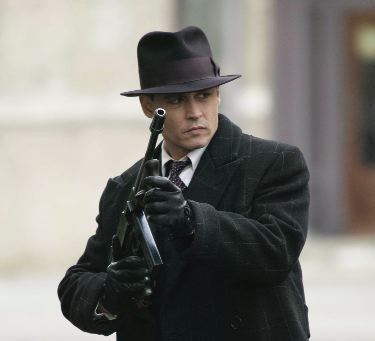Public Enemies

Halfway through Michael Mann’s Public Enemies, about the time I should have been engrossed in the tommy-guns-a-blazin’ battle between bad guy John Dillinger (Johnny Depp) and good guy Melvin Purvis (Christian Bale), I found myself staring at the beautiful overcoat Dillinger was wearing, the hip sunglasses he had on and the way Purvis’s stylish hat was nattily cocked upon his head. I tried to focus on the moral conundrum that was supposedly being posed in the tale, the oft-told story of the freelance hood who takes on organized crime, or on the erratic love story between Dillinger and hat-check girl Billie Frechette (a very believable Marion Cotillard). But those shiny shoes were simply too captivating.
Public Enemies is less a movie than a layout in GQ magazine. It’s so slickly designed and beautifully shot it’s difficult to believe in anything that transpires. It would help if the script were stronger and tried to say something meaningful or new about Dillinger or the Great Depression or the Chicago Mob or the life of a maverick thug. But all the movie does is brush up against a few themes and ideas.
The film is cool in ways that alienate rather than seduce. It lacks any sort of passion, leaving us wondering why so much time and money was spent on telling us the story of Dillinger and Purvis and J. Edgar Hoover (Billy Crudup) and the infamous “Lady in Red” yet again. Despite its huge budget, A-list stars and scenes shot at some of the actual locations (including Chicago’s Biograph Theatre, the scene of Dil linger’s death), it’s not nearly as gritty as the 1945 film Dillinger, which starred tough-guy Lawrence Tierney, or as much fun as the 1973 movie of the same name, written and directed by John Milius, which starred the great character actors Warren Oates and Ben Johnson as Dillinger and Purvis.
Expectations for gangster movies have risen considerably over the decades. Arthur Penn’s Bonnie and Clyde (1967), whose stars were every bit as attractive as those in Public Enemies (and also had stylish clothes), still inspires awe. Bonnie and Clyde worked as a love story, a tale of mythmaking, a psychological drama and a cautionary tale about a life of violence. Great gangster films give us a reason to care about the people who shatter society’s rules and get away with it, at least for a time. I am thinking of films like The Public Enemy (1931), The Roaring Twenties (1939) and White Heat (1949), all starring the iconic Jimmy Cagney, or even the melancholy, heartbreaking Once Upon a Time in America (1984), Italian director Sergio Leone’s tip-of-the-fedora to the American gangster movies that moved and inspired him as a boy.
It’s hard to believe that anyone will be moved and inspired by Public Enemies, except for the costume and production designers in the audience. There are moments of great technical expertise, especially in some of the action sequences. But that’s what we expect from a proven talent like Mann, who has helmed such stirring movies as The Last of the Mohicans and The Insider. It’s not simply a problem of style over content here. Rather, this film presents style as content. The abundance of style diminishes any moral theme. All the cruelty, sadism and murder displayed in the film come across as nothing more than a violation of fashion.





